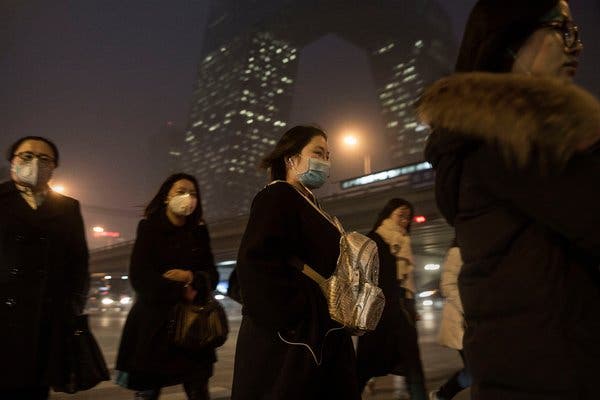
BEIJING — Researchers in China have found a significant link between air pollution and the risk of miscarriage, according to a new scientific paper released on Monday.
While air pollution is connected to a greater risk of respiratory diseases, strokes and heart attacks, the new findings could add more urgency to Beijing’s efforts to curb the problem, which has long plagued Chinese cities. Faced with a rapidly aging population, the government has been trying to increase the national birthrate, which dropped last year to the lowest level since 1949.
In a study published in the journal Nature Sustainability, scientists from five Chinese universities examined the rate of “missed abortions” in the first trimester, which can occur in up to 15 percent of pregnancies. Also known as silent or missed miscarriages, they happen when the fetus has died but there are no physical signs of miscarriage, leading the parents to mistakenly think the pregnancy is progressing normally.
Zhang Liqiang, a researcher at Beijing Normal University and lead author of the study, said such miscarriages can be “especially traumatic” for expecting parents, who often only find out about them days or weeks later. He also added that they weren’t well studied, part of the reason for the researchers’ focus.
Using the clinical records of 255,668 pregnant women from 2009 to 2017 in Beijing, the study assessed their exposure at home and at work to air pollution that comes from industries, households, cars and trucks. The researchers looked at four types of air pollutants: a deadly fine particulate matter known as PM2.5, sulfur dioxide, ozone and carbon monoxide. The levels were calculated based on historic data gathered by the network of air monitoring systems around the Chinese capital, which is notorious for its gray, soupy skies.
Among the women included in the study, 17,497, or 6.8 percent, experienced silent miscarriages in their first trimester. Taking into consideration different ages, occupations and air temperature, the researchers found that “in all groups, maternal exposure to each air pollutant was associated with the risk.”
Mr. Zhang, the lead author, said that more research was needed to ascertain the exact link between the different pollutants and the risk of missed miscarriages. In the paper, the authors of the study, which was supported by grants from three Chinese government-backed research foundations, also acknowledged that data limitations made it difficult to account for other possible contributing factors, like levels of indoor air pollution from stoves, construction materials and tobacco smoke.
Nevertheless, outside experts agreed that the findings add to the growing body of evidence about the negative effect of air pollution on the health of pregnant women and their fetuses.
“There has been a lot of evidence suggesting a link between air pollution and pregnancy outcomes in general, particularly the risk of a premature birth and a low weight baby,” said Tom Clemens, a lecturer at the University of Edinburgh who has researched the subject and was not involved in the study. “This is one of the first studies to link particle pollution to this particular outcome of pregnancy so in that sense it’s very important.”
Health concerns about air pollution have grown rapidly in China over the past decade. One recent study suggested a link between air pollution and cognitive decline. Others have shown that China’s air pollution accounts for as many as one million premature deaths a year.
Much of the anxiety has focused on children. Chai Jing, a former reporter for the Chinese state news media, once said she was motivated to make a documentary about the country’s devastating air pollution after she had complications during a pregnancy. After its release in 2015, the documentary, “Under the Dome,” quickly went viral before Chinese Communist Party censors abruptly ordered its removal from online platforms.
The public’s fears surrounding air pollution — and the implicit threat to broader social stability — have pushed government officials to try and address the issue. Those efforts, including limiting the construction of coal-fired power plants and capping the number of cars on the road, have largely succeeded. A report released last month by the Swiss firm IQAir AirVisual said that Beijing was on track this year to drop off the list of the world’s 200 most polluted cities.
But the problem persists. Earlier this month, a pale gray haze formed the backdrop to the all-important celebrations in Beijing marking the 70th anniversary of the founding of the People’s Republic of China, despite the government’s best efforts to rein in pollution. Footage of the parade showed Chinese military aircraft streaking multicolored smoke trails across grimy skies.
In the Nature Sustainability paper, the researchers said that since 2013, the risk of missed miscarriages in the first trimester had declined along with the decrease in air pollutant concentration — further evidence, they said, of the link between the two.
They concluded their paper by framing the issue in the context of another official priority: China’s declining birthrate. Alarmed by the prospect of a shrinking work force, the government has in recent years encouraged women to have more babies, in part by easing one-child policy restrictions. But those efforts so far haven’t done much to change the trend.
“China is an aging society and our study provides an additional motivation for the country to reduce ambient air pollution for the sake of enhancing the birthrate,” the researchers wrote.
Zoe Mou contributed research.

